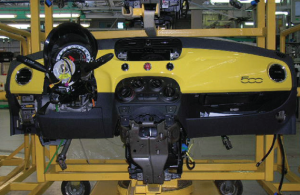Teamcenter® software solutions for sustainability and environmental compliance enable you to strengthen your compliance initiatives by facilitating an overall sustainability framework that includes the supply chain. You can meet the requirements of regulatory and industry compliance using the same PLM environment you use to accelerate product development and increase your product introduction capacity.
By applying a comprehensive PLM strategy to your product development process (which includes supply chain information from the IMDS), you not only reduce the costs associated with becoming compliant and maintaining compliance, but also ensure that products are designed right the first time, maximizing your return on investment.
Regulatory directives throughout the world require automotive original equipment manufacturers (OEMs) and their suppliers to report on the content of their vehicles. To meet this need, the International Material Data System (IMDS) was created. The IMDS is used to exchange productrelated data such as material compositions within the automotive supply chain.
With intelligently integrated solutions built on a future-proof architecture, Teamcenter helps you deliver increasingly complex products to market while maximizing productivity and streamlining global operations.
The Teamcenter substance compliance solution, from Siemens PLM Software, plays an important and growing role in helping you develop environmentally friendly products, understand and control the entire material makeup of your products and stay compliant with environmental regulations created to limit the use of hazardous substances in products.
Siemens PLM Software offers an integration between Teamcenter and Hewlett Packard’s IMDS system which allows you to aggregate supplier material data sheet (MDS) information to Teamcenter from the IMDS. Supplier MDS information can also be submitted to the IMDS from Teamcenter. The synchronization and exchange of this critical supply chain data ensures accuracy and helps expedite the process of full supplier material and substance disclosure for the OEM. This, in turn, increases productivity and reduces costs associated with collecting and managing the vast amounts of supplier material data needed to establish the compliance of complex products down to the substance level.
The advantages of a PLM-based environmental compliance strategy to enable the exchange of automotive supply chain product material-related data include the ability to:
- Intelligently integrate material and substance information from the supply chain into the product design environment, providing a single source of accurate and compliant data to support Design for Environment (DfE) initiatives
- Increase productivity and reduce administrative overhead by automating the process of aggregating supplier information to the engineering BOM
- Improved sustainability performance to make manufacturers and products more efficient and competitive
- Make and validate materials decisions earlier in the product development process where changes are less costly
- Help manufacturers make smarter decisions that result in better, more sustainable products
The Teamcenter integration to the IMDS also supports the automotive standard for supplier compliance with regard to product-related data exchange.
Teamcenter Integration for International Material Data System (IMDS)
Automotive supplier collaboration for full material and substance disclosure
Benefits
- Provides a single source for product design, including materials to support Design for Environment (DfE) initiatives
- Increases productivity with automated synchronization of material data sheet (MDS) between Teamcenter and the IMDS
- Minimizes risk of fines, restricted market access and brand damage by tracking and reporting on substances of concern used throughout the entire product
- Supports the automotive standard for supplier compliance
Features
- Automatically synchronize Teamcenter MDS with the IMDS
- Create and manage supplier part materials and substances along with the engineering BOM in Teamcenter
- Suppliers can create an MDS using Teamcenter and submit to the IMDS
- Supports standard regulatory compliance grading against regional and industry-specific directives such as REACH, RoHS and GADSL
- Single intuitive user interface to manage the MDS process
- Configurable rules engine for customer-specific directives
- Easily identify where substances of concern are used in product structures
In the automotive industry, there is a growing trend toward an increasing number of product launches on a global scale. Original equipment manufacturers (OEMs) are trying to increase their market share in new regions, and they are looking toward regional production to support this goal. That means that often times the same vehicles are being built in multiple production facilities. But that’s just the beginning of the challenges.
Automakers are under pressure to provide a greater variety of personalized options than ever before. They have to reduce costs to compete in global markets, while accommodating an increasing number of process variations to meet the demands from more discriminating consumers. As a result, automotive OEMs face continual pressure to squeeze more time out of schedules that have contracted significantly during the past decade.
To meet these challenges, automotive OEMs need to adopt new manufacturing strategies that allow them to quickly plan and design new processes; accurately assess the impact of changes; rapidly deploy best practices across global operations and better predict the timing, cost and quality of every program launch. Additionally, they must deliver more environmentally-friendly vehicles and build them with more energy-efficient processes.
To facilitate these strategies, many leading automakers are implementing a collaborative approach that integrates engineering and manufacturing in the development of the launch process. This approach allows for early access to product engineering data so that manufacturing operations work in parallel and processes can be planned, optimized and validated concurrently with design. An integrated approach increases the efficiency of deploying a modular platform that allows for a more predictable launch operation, and provides management with clear visibility into program performance.

